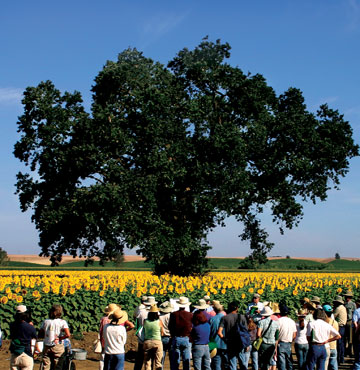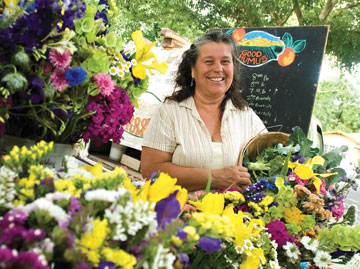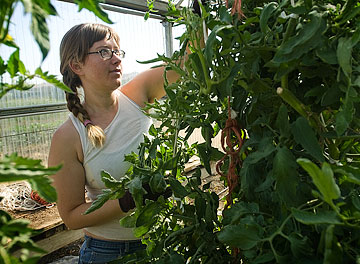Volume 25 · Number 4 · Summer 2008
Photos and audio by Karin Higgins/UC Davis Publications, produced by Susanne Rockwell, UC Davis News Service
Download: Adobe Flash (free)
Planting the Seeds of Change
Many forget that “sustainability” — a concept that’s all the rage today — had its roots in agriculture where it was a source of contention and controversy.
“We will draw more attention to our land and water, the source of sustenance and health. If we don’t get sustainability in agriculture first, it is not going to happen.” — Wes Jackson, founder of The Land Institute
Suddenly, it seems, we live in a “sustainable” world.
Browse the Internet and you’ll find sustainable coffee, cocoa, seafood, tote bags, furniture — even sustainable jet fuel. McDonald’s will even package your Big Mac in a sustainable carton.
Yes, sustainability is cool — and highly marketable. Everyone likes sustainability; we may not know or agree on what it means, but we do embrace it.
Today sustainability is a household word. But this notion that you must wisely steward necessary resources if you hope to indefinitely keep on doing whatever you’re doing was birthed by the environmental movement of the 1960s and ’70s. It took root in agriculture and international development during the 1980s and matured through the ’90s.
Many who take sustainability seriously suggest that the Iroquois “great law of peace” best articulates the spirit of sustainability: “In our every deliberation, we must consider the impact of our decisions on the next seven generations.”
The Iroquois ancestors may have envisioned peace, but “sustainability” was definitely a fighting word in 1987 when soil scientist Bill Liebhardt came to UC Davis to head the UC Sustainable Agriculture Research and Education Program.

Participants at the 2007 Sustainable Agriculture Farming Systems field day gathered at a sunflower field at Muller and Sons Farm in Woodland. (Photo: Kent Brittan, UC Cooperative Extension Farm Advisor, Yolo/Solano Counties)
“There was a lot of animosity because, once you say you’re sustainable, the implication is that everybody else is unsustainable,” said Liebhardt, who retired in 2001. “I was told that there were UC administrators who said that our program would happen over their dead bodies.”
The university’s pioneering sustainable agriculture program was created in 1986 by California Senate Bill 872, authored by State Sen. Nicholas Petris of Oakland at the urging of consumer and environmental activists.
“The legislation was a fork in the road for the direction of the land-grant system,” said Liebhardt, who counts himself a passionate proponent of that historic network of agricultural colleges.
Since the mid-1800s the land-grant colleges of agriculture have played a key role in the development and success of what is now termed “conventional agriculture.” Each decade brought new technological developments, higher yields and larger profits.
But along with booming productivity came concerns that agriculture might also be yielding unintended environmental and social problems. Evidence suggested that agricultural pesticides were polluting groundwater and leaving potentially harmful residues on food crops. Highly efficient agricultural equipment, like the UC Davis-designed mechanical tomato harvester, was relieving people of backbreaking work, but was it also depriving farm workers of employment?
In 1962, publication of Rachel Carson’s book Silent Spring, with its dire warnings about the ecological harm caused by chemical pesticides, launched the environmental movement, which, in turn, would lead to new ways of looking at agriculture.
Seeds of the ’70s
By the middle of the 1970s, a generation of UC Davis students had grown up with a new sensitivity to ecological issues. Many were coming from suburban rather than rural backgrounds, drawn to agriculture by their interest in nature and the environment.
“They had concerns about the environmental and social consequences of agriculture,” said plant scientist Mark Van Horn, a 1978 alumnus and director of UC Davis’ Student Farm. “They had a very different model of what they wanted agriculture to look like, and they also wanted something different in their education.”
In 1975, a seminar on alternatives in agriculture was first offered, and two years later a student organization on the same subject was established. With faculty support, the student group convinced the campus to set aside 20 acres for a student farm.
“The students wanted a place where they could explore organic farming — a place to get their hands dirty and experience agriculture as a whole,” Van Horn recalled. “They wanted to see research that would lead to a more sustainable agriculture.”

Annie Main ’76 at the Davis Farmers Market. Annie and husband Jeff ’76 are owners of Good Humus farm in Capay Valley. (Karin Higgins/UC Davis)
Among those students were Annie and Jeff Main, 1976 graduates and now owners of Good Humus Produce, a 20-acre organic farm in the nearby Capay Valley.
Intrigued by plants, Annie was majoring in renewable natural resources. She had hoped to become a naturalist and forest ranger until she realized that would entail “more law enforcement than sharing the love of nature.” Jeff was a civil engineering major, with a background in architecture. They met while living at the Agrarian Effort Cooperative, a shingle-sided house — which is still at the center of campus — with an environmental emphasis and a garden that supported the students living there.
“It was so much the time that directed us,” recalled Annie from her produce stand at the Davis Farmers Market.
During the 1970s, the Agrarian Effort was the hub for a cooperative living and food-buying initiative. The Mains and friends were part of a community group that decided to broaden that enterprise and start a “storefront” that embraced the philosophy of “Food for People Not for Profit.” During the transformation of the buying club into the Davis Food Co-op, Annie did an independent-study project to complete her UC Davis graduation requirements. She and others working on opening the food co-op spawned today’s wildly successful Davis Farmers Market.
The Mains and friends Martin Barnes, M.S. ’75, Kathy (Barsotti) Barnes, M.S. ’75, and Henry Esbenshade, M.A. ’77, managed the Davis Farmers Market for several years. In looking for long-term employment, the three families formed a partnership and began farming as Good Humus Produce on three-quarters of an acre in Woodland, on land owned by Howard Beeman and Susan Pelican, two of the few organic farmers in Yolo County at that time. Three years later, the partnership split into three organic farms: Good Humus Produce, Capay Fruits & Vegetables and Everything Under the Sun, all of which are still operating today.
Basic organic farming practices then were much the same as they are today: Avoid all synthetic pesticides, apply compost rather than chemical fertilizers and plant cover crops — secondary crops like grasses and legumes — to improve soil quality. The majority of their produce was sold at the only organic wholesale market in San Francisco.
Meanwhile, back on campus, students and faculty were finding new ways to explore organic and other alternative agricultural practices.
A summer sustainable farming class was started in the mid-1980s, and an organic farming course was added several years later. The student farm established a market garden to give students experience selling their produce and a children’s garden to provide educational tours for local schoolchildren.
Gaining a sustainable foothold
That was the stage Liebhardt stepped onto when he arrived to launch the Sustainable Agriculture Research and Education Program. While some faculty members shared the students’ enthusiasm for exploring agricultural alternatives, others were wary of the new movement.
“The concepts of sustainability are powerful ideas about how the planet should be managed, but at that time, they were an affront to conventional wisdom,” Liebhardt said. “That’s why there was such a clash of ideas.”
Sustainable practices, according to one definition, must be environmentally sound, economically profitable and socially responsible, requiring both farmers and scientists to think beyond their own farms or laboratories.
For farmers and farm advisors, exploring sustainable practices sometimes meant questioning long-established methods of cultivation, irrigation, fertilization and pest control. And for agricultural scientists, it meant approaching research from a more multidisciplinary, systems standpoint. Rather than only following the reductionist method of scientific inquiry — breaking complex problems down into small parts for study — researchers, instead, were being asked to examine the very broad connections between those parts.
For example, a researcher exploring new pest-control methods would have to figure out not just how to eradicate or control the pest but also how to do so without harming the environment, compromising the farm’s economic stability or endangering the health and welfare of the community.
One of the sustainable agriculture program’s first “systems” studies helped two Merced County almond farmers compare organic and conventional methods. That project eventually morphed into the Biologically Integrated Farming Systems, which conducts comparative studies for a variety of crops and is a focal point for the program. Its other four areas of interest are crop and livestock production, organic farming information, alternatives for the fumigant methyl bromide and community food systems.
Over the past 21 years, the UC Sustainable Agriculture Research and Education Program has funded scores of research projects at UC Davis and throughout California. Some proved to be major flashpoints for controversy.
Plans to launch one long-term project angered both sides — proponents of organic farming because only one of the 16 treatments would be organic, and advocates of conventional methods because an organic treatment was included at all, Liebhardt recalled.
And in 1993, the book The Dairy Debate: Consequences of Bovine Growth Hormone and Rotational Grazing Technologies, edited by Liebhardt, sparked heated criticism from some campus colleagues.
But not all sustainable agriculture projects have ignited controversy. For example, the program expanded the concept of community food systems, aimed at linking consumers with locally grown foods, says Gail Feenstra, the program’s food-systems analyst since 1989.
“At that time, the social side of sustainable agriculture was not given much attention,” Feenstra recalled. “We carved out this whole area within sustainable agriculture that spanned farmworker health, farmland preservation and farmers markets, as well as direct marketing and urban gardening.”
Out of that effort grew support for popular farm-to-school projects around the state that provide locally grown fruits and vegetables to school lunch programs, and farm-to-institution programs that encourage food services at colleges and universities to purchase local, sustainable and organic foods.
A similar farm-to-hospital program is now in the works to incorporate locally grown produce into hospital food-service programs.
Sustainability matures
Somewhere along the line, much of the friction seems to have gone out of the sustainable vs. conventional debate in agriculture. UC Davis’ new Agricultural
Sustainability Institute, created in 2005 by the College of Agricultural and Environmental Sciences, now lists 150 faculty members from a broad spectrum of disciplines who have expressed interest in sustainable agriculture.
And in industry, organic practices are no longer limited to small farms and farmers markets — consider that Safeway now has its own line of organic products and even Wal-Mart is proclaiming its commitment to sustainability.
Woodland farmer Frank Muller ’79 of Muller & Sons Farms recalled first hearing the term “sustainability” about 10 years ago when a representative of Unilever/Best Foods visited the Muller farm to announce that the company had decided to purchase only crops grown in a sustainable manner.
“We were already farming in as environmentally friendly a way as we could,” said Muller, who farms with his brothers Tom and Louie ’77.
“We felt that this was the first time someone had recognized the practices we were already using,” he said. “It was exciting that it came from industry and not from regulators.”
Muller & Sons uses organic and conventional methods on different parts of the farm. Winter cover crops and conservation-tillage practices that minimize mechanical cultivation are used wherever possible to protect the soil and save on energy expenses.
“If you build up the organic matter in the soil, it’s more tillable and you don’t have to make as many passes with a tractor. Over time that adds up,” Frank said.
For many years, the Muller brothers also have incorporated integrated pest management techniques in their operation to decrease pesticide use and have worked to judiciously match fertilizer rates with specific crops.
“Our job is to bring in these practices, which we believe in the long run will be economical,” Frank said. “You can have the greatest sustainable philosophy in the world, but if you can’t stay in business, so much for your philosophy.”
A tipping point
Over the years, many farms like Muller & Sons have incorporated sustainable techniques into their daily operations. So what moved sustainability from a threatening philosophy to one that is now broadly accepted in industry, academia and the general public?
Some say the tipping point was global warming.
“About 10 years ago, we started getting really strong evidence that human beings were dramatically impacting the world, not only at the local level but also on the national and global levels,” said Tom Tomich, who directs both the UC Sustainable Agriculture Research and Education Program as well as the new Agricultural Sustainability Institute. “The interest in global warming has made a difference. Many people are beginning to see that there are limits to our natural resources,” said food-systems expert Gail Feenstra.
“I also think the climate for sustainability is better now because we are in the context of a society that’s interested in healthy foods,” she said, noting that consumers increasingly want to know where their food is grown, who grew it and how it was grown.
Looking ahead
Sustainable agriculture has come a long way during the past three decades, but it is still a work in progress, evidenced by the lack of consensus on what constitutes sustainability.
Some organic farmers question whether a farm can truly be sustainable if it does not adhere strictly to organic methods, and some more conventional farmers contend that not all organic methods are economically sound.
“I think it’s important to have both organic and sustainable agriculture, ” said Karen Klonsky, a UC Davis Cooperative Extension agricultural economist with a special interest in alternative farming practices. “Organic has a strict, legal definition while the term sustainable agriculture is not precise.”
Although organic agriculture is now governed by state, federal and international production standards, sustainable agriculture lacks such regulatory definition.
“Sustainable agriculture is now right where organic farming was 20 years ago,” Klonsky said about its regulation. “It took 10 years to work out organic standards, and it will take even longer for sustainable agriculture to do so because this is a more diffuse group.”
As director of the UC and UC Davis sustainable agriculture programs, Tomich is optimistic about the future.
Together, the programs are operating a comparative 100-year agricultural systems study at the campus’s Russell Ranch, studying the “carbon footprint” of various crops and exploring other climate-change issues. And the campus plans to launch a new sustainable agriculture major, with core courses offered beginning in fall 2008.
Tomich anticipates that water will be at the forefront of sustainable resource issues for California in the coming years and the nutritional value of various food crops will also be in the spotlight. The university, he says, can play a critical role in bringing together a host of stakeholders to wrestle with these and other sustainability issues.
“With the big emerging issues like climate change, people see how important the environment is but they don’t know what to do about it,” he said. “Our job is to supply the science that will provide people with those environmental answers.”
Pat Bailey writes about the agricultural and veterinary sciences for UC Davis.

